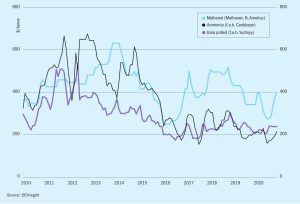
Towards a sustainable nitrogen fertilizer industry:
Georgy Eliseev , Principal Analyst at Fertecon for IHS Markit, looks at the medium to long term outlook for both ‘green’ and ‘blue’ ammonia production.

Georgy Eliseev , Principal Analyst at Fertecon for IHS Markit, looks at the medium to long term outlook for both ‘green’ and ‘blue’ ammonia production.
Copenhagen Infrastructure Partners (CIP) has unveiled plans to build Europe’s largest power-to-ammonia facility at the Danish port of Esbjerg, based on electricity from offshore wind turbines. The company said the plant will consist of 1GW of electrolysis capacity, capable of supplying sufficient hydrogen to produce 300,000 t/a of ammonia, and that the ammonia will be used as both as agricultural fertiliser and as fuel for the shipping industry. Excess heat generated in the process would be used to provide heating for around one third of local households in communities around the plant, to be sited on the west coast of Denmark. The company has signed a memorandum of understanding for the project with companies from both the agriculture and shipping sectors, including Danish Crown, Arla, DLG, Maersk and DFDS Seaways. CIP anticipates that it would cost approximately $1.2 billion to build the facility. They are currently seeking investors for the project and expect that the investment decision would be reached by 2023. The plant could enter commercial operations in 2026.
The United States has imposed duties on Russian and Moroccan phosphate imports.

Fertilizer International presents a global round-up of phosphate rock, phosphoric acid and finished phosphates projects.

It can’t have escaped anyone’s notice that the question of the carbon intensity of ammonia and downstream nitrogen compound production has been one of the main industry talking points for the past year. Everyone seems to be talking about ammonia of different colours – green ammonia, blue ammonia, and all shades of turquoise in between. If you are confused, it may not be surprising, as these words have come to cover a wide variety of different methods and technologies for producing ammonia, and their green credentials consequently come in a whole range of different shades.
Building on its long experience and leading position within global ammonia production, logistics and trade, Yara says that it aims to capture opportunities in green shipping, agriculture and industrial applications; a market expected to grow by 60% over the next two decades. A major first step includes plans to fully electrify its ammonia plant at Porsgrunn, Norway, with the potential to cut 800,000 t/a of CO 2 , equivalent to the emissions from 300,000 passenger cars.

Ammonia supplies have been curtailed by production shutdowns, including Kaltim and PT PAU in Indonesia, SABIC and Ma’aden in Saudi Arabia, Sorfert in Algeria and Chinese gas-based producers. There have also been gas curtailments in Iran and Trinidad.
Illinois-headquartered CF Industries has made a long-term commitment to low-carbon ammonia production and net-zero emissions.

Latin America has confirmed its status as a pre-eminent global marketplace for fertilizers. We report on demand growth and fertilizer supply and capacity developments within this diverse region.

Brazil’s phosphate industry is on a growth dash to meet rising domestic demand. We report on the major acquisitions, investments and expansions by CMOC, Mosaic, Yara and Itafos.